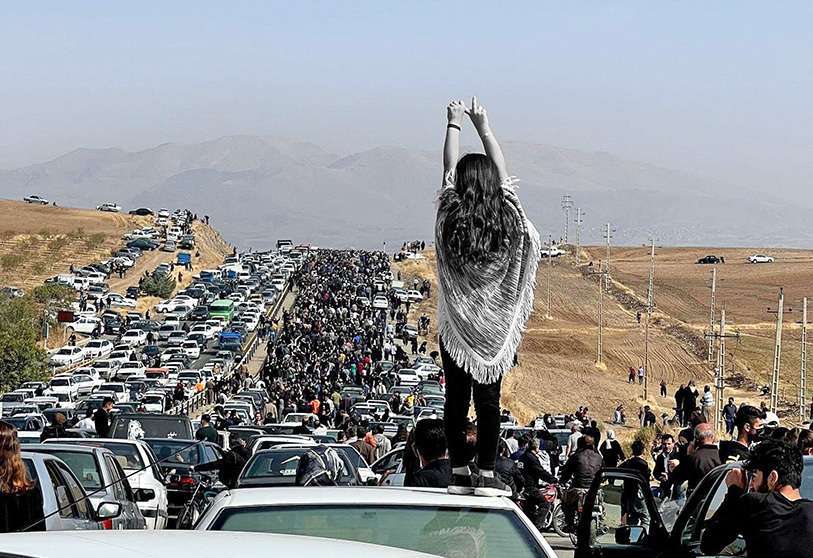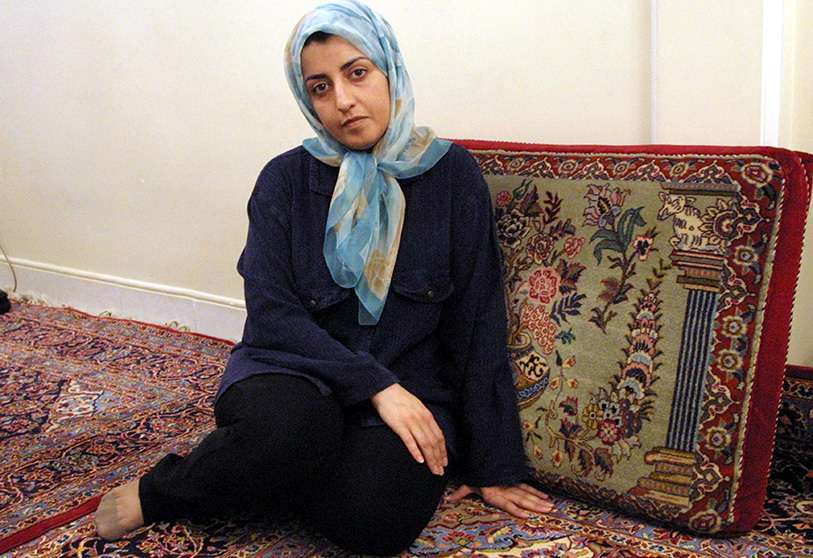Iranian women lead protests with significant support from men
Although the protests in Iran began at the end of the year, they have become one of the main events of 2022. The development of these protests will also be one of the events to follow in the coming year. More than 40 years after the triumph of the Islamist Revolution in the country, Iranian citizens are putting the Ayatollahs’ regime in check.
It all started with the brutal murder of a 22-year-old Kurdish woman. Mahsa – or Jina – Amini had travelled to Tehran with her brother when the dreaded Morality Police stopped her for wearing the Islamic headscarf incorrectly. After several hours in custody, the young woman was taken by ambulance to a hospital in the capital with serious injuries. She did not make it out alive.
 AFP PHOTO / UGC IMAG – Iranian women are leading the protests with significant support from men
AFP PHOTO / UGC IMAG – Iranian women are leading the protests with significant support from men
It all started with Mahsa Amini, although there were other aspects behind it that made it easier for the fuse to be lit in Iran, such as strong oppression and censorship, economic crisis and corruption. Similarly, in regions such as Kurdistan – Amini’s place of origin – or Sistan and Baluchistan, there was also strong discontent with the government after periods of discrimination and repression. “This time the people want to overthrow the entire regime and have targeted the regime’s top person, Ali Khamenei,” explains Middle East analyst Mehdi Dehnavi.
During the first weeks of protests it was common to see women burning hijabs or taking them off in public, as this was the main cause of Amini’s murder and that of many other women. However, over time, Iranians – both at home and abroad – have emphasised that the demonstrations are no longer just about the hijab or the Morality Police. Iranians want regime change.
 AFP/ATTA KENARE – “This time the people want to overthrow the entire regime and have targeted the first person in the regime, Ali Khamenei”
AFP/ATTA KENARE – “This time the people want to overthrow the entire regime and have targeted the first person in the regime, Ali Khamenei”
For Ryma Sheermohammadi, Spanish-Iranian activist and translator, this change is inevitable. Sheermohammadi stresses that this change will undoubtedly bring stability and peace to the Middle East. In this regard, she recalls Iranian interference in Syria and Lebanon, as well as in the war in Yemen.
“People want regime change. They don’t want reforms, this goes beyond that,” says Ali Nowroozi, an Iranian resident in the UK. Nowroozi is also confident of such change. “It has happened before and it will happen again,” he says.
The wave of protests that began last September is turning into a real revolution and, although its consequences are still unknown, it is marking a before and after in Iran. For the time being, these protests can be described as “historic” since, for the first time, they have been led by women. “The revolution started with women, this is very powerful,” adds Nowroozi.
 AFP/YASIN AKGUL – Nasibe Samsaei, an Iranian woman living in Turkey, cuts off her ponytail during a protest outside the Iranian consulate in Istanbul
AFP/YASIN AKGUL – Nasibe Samsaei, an Iranian woman living in Turkey, cuts off her ponytail during a protest outside the Iranian consulate in Istanbul
The role women are playing in the protests is key. Their slogan “Jin, jiyan, azadî” (Kurdish for “woman, life, freedom”) has reached all corners of the world, while their courage, bravery and strength have inspired women in equally oppressive countries such as Afghanistan.
Many of these women have died fighting for their freedom, while others have been detained by security forces and suffer constant abuse such as rape and torture. A recent report by The Guardian revealed that many of the women arrested had been shot in the face and genitals.
 AP/ALESSANDRA TARANTINO – An Iranian woman before the start of the Wales-Iran football match
AP/ALESSANDRA TARANTINO – An Iranian woman before the start of the Wales-Iran football match
Around the world, the role of women and their importance in bringing about social and political change has been recognised. Even the famous TIME magazine named Iranian women the heroines of the year 2022. TIME has highlighted a few of them, such as Gohar Eshghi, Narges Mohammadi, Sepideh Gholian, Niloufar Bayani, Elnaz Rikabi, Zahra Amir-Ebrahimi, Nazanin Zaghari-Ratcliffe or Roya Piraie.
 AP/ANDRE PENNER – Iranians living in Brazil protest against the death of Mahsa AminiGohar Eshghi’s tireless struggle
AP/ANDRE PENNER – Iranians living in Brazil protest against the death of Mahsa AminiGohar Eshghi’s tireless struggle
Gohar Eshghi has become a symbol of resistance and strength in Iran. Eleven years after the authorities tortured and murdered his son Sattar Beheshti, a blogger critical of the regime, Eshghi continues to demand justice and denounce the Iranian government’s violence.
At 76, Eshghi is a tireless defender of human rights in Iran. In addition to being a member of the “Iranian Mothers Whistleblowers” – a group of women demanding justice for the murders of their children – Eshghi has joined the protests following Amini’s death, even taking off her Islamic headscarf in solidarity with the demonstrators.
Because of her involvement and influence, Eshghi is often threatened by the authorities. She has claimed that the regime has recently increased pressure on her and her family. “If anything happens to us, Khamenei is responsible,” she said in a video.
In addition to threats and pressure, Eshghi has been under attack. As reported by Iran International, last year she was assaulted by two strangers while visiting her son’s grave.
Neither torture nor illness can silence Narges Mohammadi
Narges Mohammadi is one of many people imprisoned in Iran for speaking out against Tehran. Mohammedi, a journalist and vice-president of the Centre for Human Rights Defenders – an institution headed by Iranian Nobel Peace Prize laureate Shirin Ebadi – has received numerous awards for her work as a journalist and human rights activist. The most recent award she received was the Press Freedom Award 2022, given by Reporters Without Borders.
“Narges Mohammadi is a symbol of courage. Even from prison, she continues to report on the situation of prisoners, especially women. Her life is a constant struggle, in which she has to make many sacrifices to make her voice heard. Mohammadi is known for her numerous articles denouncing the human rights situation in Iran, as well as for her documentary and study on “White Torture”, based on interviews with prisoners.
 AFP/BEHOURZ MEHRI – Narges Mohammadi
AFP/BEHOURZ MEHRI – Narges Mohammadi
After her stay in Evin – a prison that holds many political prisoners and which was burned down during protests last October – Mohammadi was transferred to the Shahr-e Ray prison, known as Qarchak. “Qarchak prison is notorious for its inhumane treatment of prisoners, torture, abuse and rights violations,” warns the Coalition of Women Journalists (CFWIJ). Mohammadi shares a prison with fellow Iranian journalist Alieh Motalebzadeh.
Amnesty International has denounced the torture and ill-treatment of Mohammadi, who was sentenced to 10 years and eight months in prison and 154 lashes in January. The journalist, who suffers from heart problems, has not received medical attention or adequate treatment in prison. The authorities have also denied Mohammadi the possibility of visits from her children.
Sepideh Gholian, the voice of Iranian women in prison
Another Iranian woman imprisoned for speaking out against the situation in the country is Sepideh Gholian, a 27-year-old writer who has described the torture and abuse women face in the country’s prisons. Beatings, humiliation, threats, insults and interrogations lasting more than 24 hours are some of the methods used by the authorities against Gholian, she told Amnesty International.
Gholian is currently being held in a prison far from her home, despite her family’s pleas. According to Iran Wire, this is a tactic commonly employed by the judiciary to put further pressure on so-called “prisoners of conscience”.
Niloufar Bayani, imprisoned for her environmental work
The Iranian authorities not only imprison women who openly criticise the regime, but also women who carry out their work outside politics. This is the case of Niloufar Bayani, an environmental researcher specialising in the conservation of flora and fauna. In 2018 Bayani was arrested along with other researchers for using cameras to track endangered species. Although Bayani and her group only wanted to monitor the Asiatic cheetah, the authorities accused them of spying and collecting classified information on strategically sensitive areas.
Bayani, who was sentenced to 10 years in prison, told the BBC that after her arrest, the Revolutionary Guards subjected her to “the most severe mental, emotional and physical torture, as well as sexual threats for at least 1,200 hours”.
Climber Elnaz Rekabi defies regime by competing without hijab
In October, amid protests sparked by Amini’s death, Iranian climber Elnaz Rekabi was at an Asian championship in South Korea. Despite being thousands of kilometres away from her country, she found a way to express her support for the protesters.
Like women in Iran, Rekabi took off her hijab and chose to compete without it in protest at Amini’s death. The images went around the world and social media praised the courage of the climber, who was greeted by a crowd when she arrived at Tehran airport. However, with her arrival in the country, fears began to grow about possible reprisals by the regime.








